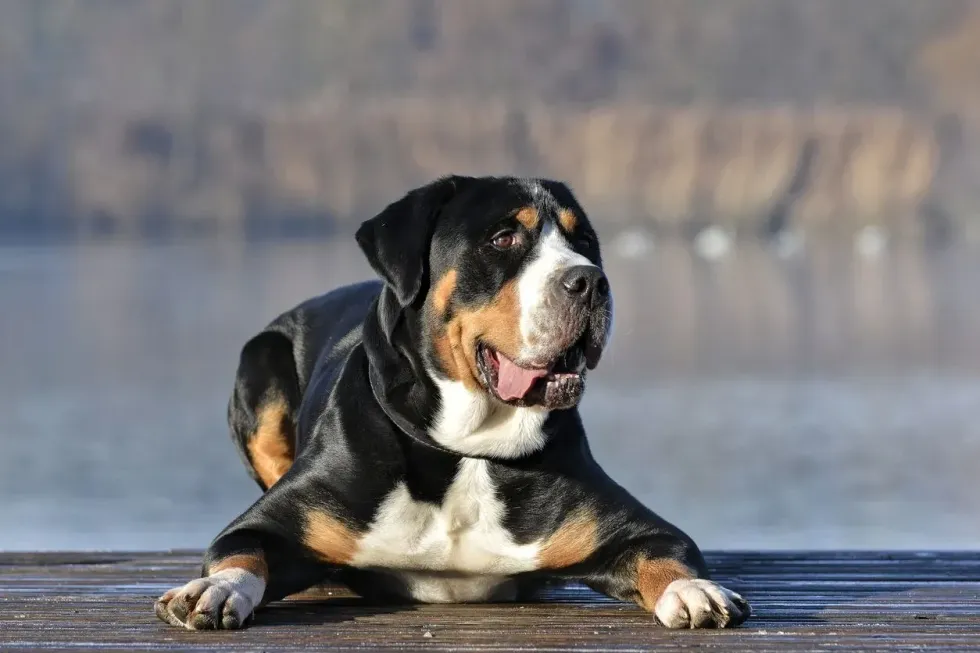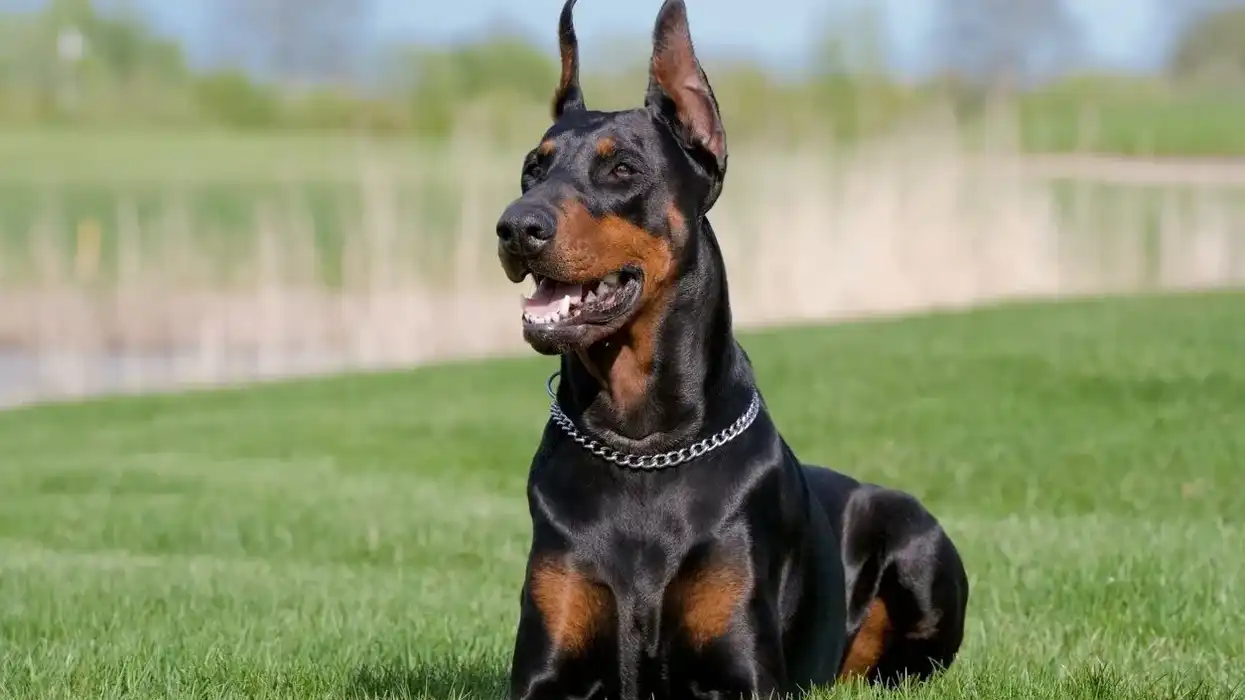What is this dog breed really 'greater' than? Let's find out.
A Greater Swiss Mountain dog, standing up to 28.5 in (75 cm) tall and weighing as much as a midsize human, could comfortably out-compete most people in a strength competition and do complete justice to the word 'greater'. The Swiss Mountain dog, (Grosser Schweizer Sennenhund), is mighty and agile enough to drive a flock over a mountain's sloping foothills.
They were once used as draft dogs. Greater Swiss Mountain dog breeds were developed to be a flexible working dog that could herd cattle, pull carts, and patrol.
The Swissy (Greater Swiss Mountain dog) is now a great family pet, but if you have kids at home, you'll have to be slightly wary. They are highly active, confident, and mouthy.
This dog is affectionately referred to as 'Swissy' by fans of the breed. The dense outer coat is a striking black, red, and white tricolor. A white marking (referred to as the 'blaze') close to the head and muzzle usually sets off a sweet smile in people.
The Greater Swiss Mountain dog's history is uncertain. For three decades, beginning in 1515, Switzerland's small valleys were more or less cut off from the rest of the country. It probably was the draft dog in Switzerland. Inbreeding produced unique breeds, and puppies were given to neighbors and family members.
This draft dog breed is big, heavy-boned, and physically strong, but it is still versatile enough to perform the all-purpose farm tasks for which it was created. The standard of the breed have a black, white, and rust coat color.
Greater Swiss Mountain dogs are a hyperactive, friendly, relaxed, and dignified breed who enjoy being a family member.
It is a surprisingly stable breed for its age, with far fewer issues than more common species in the same size range. Out of the Sennenhunde (Swiss Mountain Dogs), this breed is the oldest and largest.
If these facts about the Greater Swiss Mountain dogs garnered your attention, read our other facts on the pocket pitbull and the American bully.
Greater Swiss Mountain Dog Interesting Facts
What type of animal is a Greater Swiss Mountain dog?
Greater Swiss Mountain dogs were created to be a versatile working dog capable of herding sheep, pushing carts, and guarding. The Swissy is now a family pet, but they still love being busy because of their working background.
What class of animal does a Greater Swiss Mountain dog belong to?
Greater Swiss Mountain dogs belong to the Mammalian class.
How many Greater Swiss Mountain dogs are there in the world?
There isn't much information available on the Greater Swiss Mountain dog's population. But it is believed that there are plenty, so their population is not at risk of being endangered anytime soon.
Where does a Greater Swiss Mountain dog live?
Swissies are not suitable for apartments or condos because these dogs are huge fans of the outdoors. This large breed finds it ideal to live in a house with a fenced yard. This breed loves spending time outside, particularly in cold weather, as it is a typical working dog.
What is a Greater Swiss Mountain dog's habitat?
This dog breed is a giant breed that was developed to protect livestock in the Swiss Mountains. They love big and spacious farms and green land.
Who do Greater Swiss Mountain dogs live with?
When well socialized and educated, adult Greater Swiss Mountain dogs are gentle and loyal to their owners. They are very confident dogs and are not fearful of strangers or hostile toward other dogs.
However, they can chase cats or other creatures, and their herding nature can kick in while they are around children. They usually live with their human companions or in animal rescues and shelters.
How long does a Greater Swiss Mountain dog live?
For large dog breeds, they have a relatively average life span. Greater Swiss Mountain dogs live for an average of ten to 12 years, but this varies based on the dog's general health and welfare and the kind of climate in which the breed lives in.
How do they reproduce?
Greater Swiss Mountain dogs are the result of indigenous dogs breeding with large mastiff-type dogs imported by foreign settlers. Breeds can genetically aggregate into groups of recently shared ancestors, according to evolutionary hierarchy.
The linked pairs of Greater Swiss Mountain dog and Bernese Mountain dog are challenging to discern using a genetic clustering algorithm. The Greater Swiss Mountain dogs breed mainly in an artificial manner.
There exists a lot of inbreeding as well. A capitalistic industry around artificial breeding is growing, and experts from the field help breed Greater Swiss Mountain dog puppies.
What is their conservation status?
These Swiss dogs are not under any conservation threat, and the Greater Swiss Mountain dog rescue is not a primary concern. This breed can be easily bred whenever needed. However, these draft dogs do experience several health problems ranging from orthopedic issues to various diseases.
Greater Swiss Mountain Dog Fun Facts
What do Greater Swiss Mountain dogs look like?
They are big dogs with a tricolor short-haired double coat, a gentle smile, dark-brown eyes, triangular-shaped drop ears, and a long tail. The Swissy is always eager to please and impress.
The breed has white markings closer to the head. The coat of the Greater Swiss Mountain dogs is small and easy to groom.
They do shed, but brushing once a week, or more often during shedding season, can help keep loose hair under control. Clean the Swissy's ears and nails if appropriate, and bathe them when they're muddy to keep their tricolor coat shining.
How cute are they?
The Greater Swiss dog breed is adorable. The puppies are sold at very high prices in the United States, due to their cuteness.
How do they communicate?
In nature, the Greater Swiss Mountain dog breed is self-assured, and it is gentle with children. They can be obstinate and adamant.
Greater Swiss Mountain dogs are very smart dogs who are easy to understand. Some Greater Swiss Mountain dogs are dominant or aggressive when it comes to other dogs of the same sex. Some of these puppies have good instincts to track down and catch running cats and other species.
They possess a fiery personality. Greater Swiss Mountain dogs' personality is beautiful, but they are not easy to raise and train.
How big is a Greater Swiss Mountain dog?
The male dogs grow up to somewhere between 25.5–28.5 in (64-72 cm), while the female bitches grow up to 23.5–27 in (59-68 cm). This height is around a third of the height of an average human male.
These dogs are massive and need a lot of free space to run around.
Since they grow to be humongous when fully grown, obedience training and socialization (teaching the dog to be polite with other dogs and people) must begin early. As the Swissy is reluctant to mature, both physically and psychologically, you will have to take care of them as they will remain in puppyhood until the age of three.
How fast can a Greater Swiss Mountain dog run?
It is not appropriate for the Greater Swiss Mountain dog to run for lengthy periods. Though this family companion can be taken out on runs, it is not the best dog for running. The speed of this breed has not been accurately estimated.
How much does a Greater Swiss Mountain dog weigh?
The males of this species weigh somewhere between 105-140 lb (47-63 kg), while the females weigh 85-110 lb (38-49 kg). These dogs can weigh as much as an average human being, which explains their strength and activity level. The breed carries high muscle mass.
What are the male and female names of the species?
The male of the Swissy breed is called a dog or a stud, while the breed's female is called a bitch or a dam.
What would you call a baby Greater Swiss Mountain dog?
The Greater Swiss Mountain dog's baby is called a puppy. It is continued to be called a puppy until it grows up to be two years old.
This age is the best time for their training purposes. The training of these puppies should be mindfully approached with proper methods. The better the puppies are trained, the better the Swissy dogs will grow up to be.
What do they eat?
For an adult Greater Swiss Mountain dog, the average dietary volume is four to five cups of high-quality dry food separated into two meals. Large-breed dogs, such as the Swissy, need gradual, steady development to avoid orthopedic issues like hip dysplasia.
Are they slobbery?
Yes, the Greater Swiss Mountain dog is slobbery. Drooling is uncommon in the Bernese Mountain Dog, which is one difference between the two dogs, but those with loose jowls tend to drool a lot. The slobber will get all over the dog, the yard, and even on you if you love cuddling with the dog.
Would they make a good pet?
The Swissy is now considered to be a family pet, though they're not great at it. Make sure to train the dog not to push your children around as they can get very excited around children.
From obedience to weight lifting, this powerful breed excels in a variety of dog sports. They're affectionate and playful, but they're still big doggies that aren't suitable for inexperienced owners.
Did you know...
On the 25th year of the incorporation of the Swiss Kennel Club in 1908, Franz Schertenlieb presented two short-haired Bernese Mountain dogs to geology professor Albert Heim, a supporter of the Swiss Mountain dog.
Heim remembered them as descendants of a long-extinct big mountain dog whose ancestors had been raised as patrol dogs, draught dogs, and droving cattle dogs all over Europe.
Thus, Professor Heim was the reason behind the reintroduction of this species.
Characteristics and health issues
Swissies have a gentle, warm, and fun-loving attitude with a high energy level. They aren't laid-back, obedient dogs; they're assertive canines who have their own opinions, and they can be persistent at times. Swissy dogs do well with trainers who can be kind and strong leaders, because of their fearless personalities.
The breed (Greater Swiss Mountain dog) has some health problems that can be troublesome, mainly if you don't procure it from a reliable breeder.
Elbow dysplasia and other orthopedic conditions such as panosteitis, osteochondritis dissecans, distichiasis, gastric torsion, epilepsy, and urinary incontinence are among these many health issues. While not every Swissy will develop all (or even any) of these issues, being aware of them will assist you in your quest for a breeder.
A respectable breeder would be forthright and frank about the breed's health issues and the frequency of which they arise in their lines.
Von Willebrand's Disease (VWD), hypomyelination, asthma, hypothyroidism, hepato-cerebellar degeneration, and progressive retinal atrophy (PRA) are the health problems experienced by the Bernese Mountain dog breed.
Getting your own Greater Swiss Mountain dog
This massive dog can cost anywhere from 1,000 to 2,500 USD if purchased from a legitimate breeder. The dog (Greater Swiss Mountain) makes an excellent companions for families.
These puppies are expensive and difficult to come by, as they belong to the rare breed club, but fans swear they are worth it. The United States is known to be one of the best places to buy this dog. You can even decide to adopt these cute puppies from animal rescues and give them a loving home.
Here at Kidadl, we have carefully created lots of interesting family-friendly animal facts for everyone to discover! Learn more about some other mammals, including bullmastiff or basenji dog.
You can even occupy yourself at home by drawing one of our Greater swiss mountain dog coloring pages.










